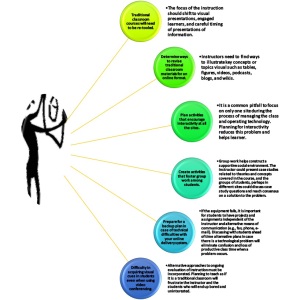
Scenario: A training manager has been frustrated with the quality of communication among trainees in his face-to-face training sessions and wants to try something new. With his supervisor’s permission, the trainer plans to convert all current training modules to a blended learning format, which would provide trainees and trainers the opportunity to interact with each other and learn the material in both a face-to-face and online environment. In addition, he is considering putting all of his training materials on a server so that the trainees have access to resources and assignments at all times.
There are four questions to consider when creating a best practices guide for the trainer. They are:
1. What are some of the pre-planning strategies the trainer needs to consider before converting his program?
2. What aspects of his original training program could be enhanced in the distance learning format?
3. How will his role, as trainer, change in a distance learning environment?
4. What steps should the trainer take to encourage the trainees to communicate online?
What are some of the pre-planning strategies the trainer needs to consider before converting his program?
Planning an online course for the first time should begin 3-5 months in advance of the course’s start date. The training manager needs to consider the following components necessary for a successful online course: the learners, the content, the method of delivery, the material, the learning environment, and the technology necessary for learning to occur (Simonson, Smaldino, Albright, & Zvacek 2012, p.137).
The training manager should consider creating a questionnaire or survey for trainees to help determine their interest in receiving training in a hybrid learning environment. Also, this should be done to determine how technology savvy the trainees are before starting any training. This would help the training manager determine which CMS method to use in training the trainees and creating a feedback mechanism. The feedback may help him determine whether the blended-learning environment is really the right format for his training.
Simonson, Smaldino, Albright, & Zvacek (p. 127)
|
The training manager will need to determine whether to use a course management system (CMS) or a learning management system (LMS). According to Associate professor Saul Carliner, corporations use learning management systems and most educational organizations use course management systems. The training manager would probably want to consider using Don Clark’s Backwards Planning Model, which is Kirkpatrick’s Four Level Training Evaluation Model in reverse, as part of his preplanning.
Project requirements are:
Convert all current training modules to a blended learning format
A series of standalone reusable modules are needed
Training modules must be engaging with activities
Provide trainees and trainers the opportunity to interact with each other
Learn environment will be face-to-face and online environment
Convert all training materials (resources and assignments) and upload them to a server for 24/7 availability (Simonson, Smaldino, Albright, & Zvacek, 2012, p.125).
What aspects of his original training program could be enhanced in the distance learning format?
All instructional material does not needs to be developed by the instructor as new resources. Nevertheless, the instructor needs to be concerned about copyrighted material such as images, photos and videos when using existing material in online courses (Simonson, Smaldino, Albright, & Zvacek, 2012, p.193).
Synchronous learning environments
Many traditional classroom instructional approaches can be incorporated in a synchronous environment. Short lectures help facilitate instruction. Small- and large-group activities can be incorporated into the audio and video components as a live situation. Learners should not remain passive” (Simonson, Smaldino, Albright, & Zvacek, 2012, p.189).
Asynchronous learning environments
The trainer has to find ways to facilitate the learner in the absence of the face-to-face environment. “The challenge is to select methods of teaching that provides learners with enough interaction to keep them on task and encourage them to become more student-centered and explore their learning experiences. Strategies such as problem-based learning, collaboration, and student-led discussions work well in asynchronous settings” (Simonson, Smaldino, Albright, & Zvacek, 2012, p.189-190).
How will his role, as trainer, change in a distance learning environment?
According to Dr. George Piskurich (2010), the methods used to facilitate online and traditional courses remain the same. However, it is more difficult to perform the role and communication in an online environment.
In a distance learning course:
Facilitators should not resort to PowerPoint presentations because it is an “unengaging way to deliver content in an online or virtual environment” (Piskurish, 2010).
Activities are more important in a distance learning environment. Although the content is critical, it is the activities that keeps the learner going and enthusiastic and helps them learn the content.
Facilitators must keep in constant contact with the learners. It is very difficult for a facilitator to communicate with all the learners. However, the facilitator can’t dissociate himself/herself in the online environment.
What steps should the trainer take to encourage the trainees to communicate online?
The trainer should foster a learner-centered learning environment by engaging the trainees in stimulating collaborative activities such as small group projects and by setting up thought-provoking discussion threads and requiring the trainees to respond to a minimum number of student posts. “The threaded discussion is one of the most powerful techniques used in distance education” (Simonson, Smaldino, Albright, & Zvacek, 2012, p. 186).
In an asynchronous environment, the trainer could create trainee debates and trainee-moderated discussions, have the trainees create and respond to one another’s blogs, or collaborate on projects by using Wikis. For synchronous communication, trainees can be encouraged to communicate using audio- and video-conferencing tools, participate in online chats, and instant messaging.
References
Clark, D. (2008) Kirkpatrick’s four-level training evaluation model
http://www.nwlink.com/~donclark/hrd/isd/kirkpatrick.html
Piskurich, G., Laureate Education (Producer). (2010). Facilitating online learning. [Online]. Retrieved
from Walden University eCollege.
Simonson, M., Smaldino, S., Albright, M., & Zvacek, S. (2012). Teaching and learning at a distance:
Foundations of distance education (4th ed.) Boston, MA: Pearson







